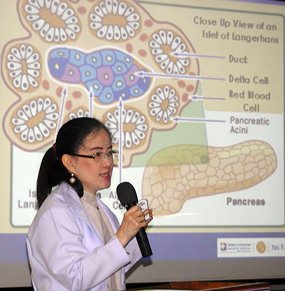About one in every ten people has diabetes. This was part of the message given about diabetes at the Pattaya City Expats Club meeting on Sunday, May 18, by Dr. Mayura Tepkasetkul. She works at the Diabetes Mellitus & Endocrinology Center of Bangkok Hospital Pattaya (BHP). In addition to her presentation, BHP provided free glucose blood sugar tests and blood pressure checks for members and guests.
Diabetes (also known as diabetes mellitus) is a disease caused by high blood sugar. Diabetes is due to either the pancreas not producing enough insulin or to the cells of the body not responding properly to the insulin that is produced. Dr Mayura said that, globally, about 371 million have diabetes, 90% of which have Type 2 diabetes. She added that by 2030 the number of people with diabetes is expected to reach 500 million.
 Dr. Mayura Tepkasetkul works at the Diabetes Mellitus & Endocrinology Center of Bangkok Hospital Pattaya (BHP). In addition to her presentation, BHP provided free glucose blood sugar tests and blood pressure checks for members and guests.
Dr. Mayura Tepkasetkul works at the Diabetes Mellitus & Endocrinology Center of Bangkok Hospital Pattaya (BHP). In addition to her presentation, BHP provided free glucose blood sugar tests and blood pressure checks for members and guests.
China and India, which have the world’s largest populations, also have the largest number of people with diabetes: 92 million and 63 million respectively. The USA has 24 million people with diabetes.
According to the Health intelligence website (http://healthintelligence.drupalgardens. com), North America and the Caribbean is the region with the highest prevalence (11%) followed by the Middle East and North Africa (9.2%). According to the National Health Examination Survey (NHES), in Thailand prevalence of diabetes in individuals aged 15 and over has increased over time from 2.3% in 1991 to 4.6% in 1997, to 6.8% in 2004, and to 6.9% in 2009. (See www. globalizationandhealth.com/content/9/1/11.)
There are three main types of diabetes mellitus: (a) Type 1 diabetes results from the body’s failure to produce insulin; (b) Type 2 diabetes results from insulin resistance, a condition in which cells fail to use insulin properly, sometimes accompanied by insulin deficiency; and (c) Gestational diabetes which occurs when pregnant women without a previous diagnosis of diabetes develop a high blood glucose level.
She mentioned that the classic symptoms of untreated diabetes are weight loss, frequent urination and increased hunger. Symptoms may develop rapidly (in weeks or months) in Type 1 diabetes, while they usually develop much more slowly and may be subtle or absent in Type 2 diabetes. Prolonged high blood sugar (or glucose) can cause glucose absorption in the lens of the eye, which leads to changes in its shape, resulting in vision changes. Blurred vision is a common complaint leading to a diabetes diagnosis. A number of skin rashes can occur in diabetes.
 MC Richard Silverberg presented Dr Mayura with a Certificate of Appreciation from Pattaya City Expats Club, as a thank you for her comprehensive presentation.
MC Richard Silverberg presented Dr Mayura with a Certificate of Appreciation from Pattaya City Expats Club, as a thank you for her comprehensive presentation.
Dr. Mayura explained that some symptoms are more common in Type 1 diabetes – i.e., weight loss, lethargy, abdominal pain or discomfort, and hyper-ventilation. Over time, high levels of blood sugar can lead to eye disease, heart disease, stroke, kidney disease, impaired blood flow to the lower legs, and nerve damage.
 Board member Darrel Vaught, also Media Manager, advises members of updates to both the newsletter and the website.
Board member Darrel Vaught, also Media Manager, advises members of updates to both the newsletter and the website.
Diabetes is a chronic disease for which there is no known cure except in very specific situations. Management of diabetes centres on keeping blood sugar levels as close to normal as possible without causing hypoglycemia (too low a level of blood sugar). Sometimes, this can be accomplished with just diet and exercise. In the slides she used for her presentation, Dr. Mayura listed the “top 20 power foods” for people with diabetes. The list included asparagus, blueberries, red grapefruit, beans, broccoli, carrots, fish, flaxseed, cranberries, apples, melon, nuts, oatmeal, red onions, raspberries, spinach, soy, tea, tomatoes and yogurt.
If diet and exercise are not sufficient, oral medications (for Type 2 diabetes) and insulin (for Type 1 diabetes) are added. Insulin can also be used for Type 2 diabetes if the oral medications are not effective.
Metformin is generally recommended as the first line treatment for Type 2 diabetes. If metformin alone is not sufficient to bring blood sugar levels under control, another drug may be added in combination, possibly from one of the following classes of drugs: sulfonylureas, thiazolidinediones and DPP-4 inhibitors. It is also possible to use a three-drug combination. A new treatment mentioned by Dr. Mayura is being studied and could become available in a year or so. It is called Glukagon-like peptide-1 (GLP-1). It would likely be administered as a once-a-week injection.
Dr. Mayura said that as part of managing diabetes, many people monitor their blood sugar levels using a glucose meter. According to the Mayo Clinic, target levels are: after fasting at least eight hours – between 90 and 130 milligrams per decilitre (mg/dL) or 5 and 7 millimoles per litre (mmol/L); before meals – between 70 and 130 mg/dL, or 4 and 7 mmol/L; and one to two hours after meals – lower than 180 mg/dL, or 10 mmol/L.
After the presentation, Master of Ceremonies Richard Silverberg brought everyone up to date on upcoming events and then called on Roy Albiston to conduct the always interesting and informative Open Forum; where question are asked and answered about expat living in Thailand, especially Pattaya.
For more information on the Pattaya City Expats Club and their many activities, visit www.pcecclub.org.




